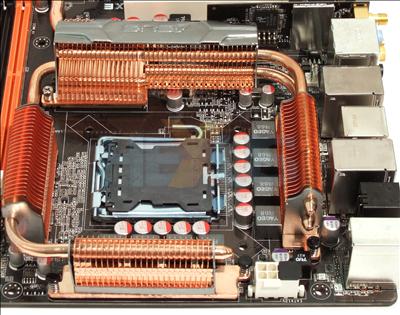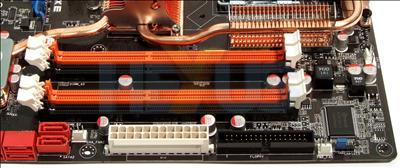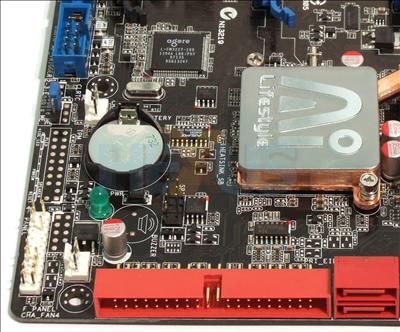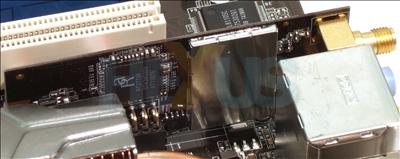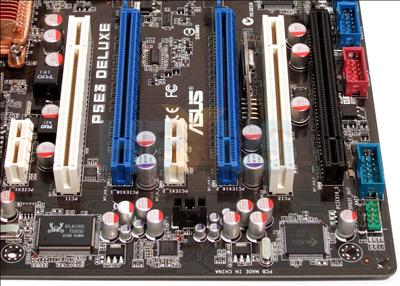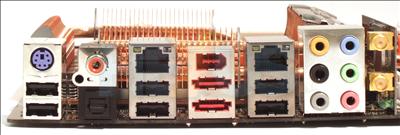Layout and features
The ASUS P5E3 is based around Intel's X38 chipset which we took at here. Summing it up, X38 supplants the incumbent P35 as enthusiast chipset of choice. X38 supports up-to DDR3-1333 memory right off the bat, some behind-the-scenes optimsations to the northbridge, allowing for super-fast memory access, and, finally, 2 PCIe 2.0 x16 lanes for full-bandwidth support. We also drew attention to the chipset's XMP memory technology, which is thinly-veiled competitor to NVIDIA's EPP - offering inbuilt profiles on compliant DDR3 memory for easy configuration.
Foxconn's X38A supports both DDR2 and DDR3 memories, offering you the chance to use existing RAM and upgrade to high-bandwidth 'D3 when pricing plummets to reasonable levels. ASUS' P5E3 Deluxe, however, goes for the performance jugular by providing only DDR3 DIMM slots, meaning that most prospective purchasers will need to buy the board and memory at the same time.
The P5E3 has a clean-looking layout that resembles the P5K3 Deluxe's - ASUS' P35 chipset-based motherboard that also supports DDR3 memory at a faster-than-default 1333MHz.
A large heatpipe cools both chipset bridges and all VRMs concurrently. We already know that the X38 chipset officially supports Intel's 1333MHz FSB processors, so the extra cooling is designed to aid overclocking to 1600MHz FSB and beyond, we imagine.
What you can't see in the above picture, hidden as it is under the left-hand heatpipe, is ASUS' EPU (Energy Processing Unit). The EPU takes the form of a discrete ASIC that digitally monitors and controls the board's power levels - all controlled by bundled software. The advantage of adjusting power granularity this way, ASUS reckons, lies with removing the CPU overhead associated with traditional software-based power-management systems. Handily, too, the EPU gives on-the-fly readings of current wattage draw, which is nice.
Mainboard manufacturers realise that the X38 is a premium chipset that currently vies with NVIDIA's DDR2-supporting nForce 680i SLI. As such, we expect to see the majority of boards to be equipped with DDR3 support, although some, like the aforementioned Foxconn X38A, sacrifices slots for dual-format compatibility. The ASUS P5E3 Deluxe gives you full-fat DDR3 support right up to a chipset-specified DDR3-1333MHz, assuming one is using latest Intel dual- and quad-core processors. Overclocking the CPU's FSB will increase the available memory speed, obviously.
The heatpipe-clad southbridge is still the ICH9R - as seen on higher-specced P35 motherboards. Six SATA2 ports are accounted for on the edge of the board, and JMicron's JB363 controller adds PATA support, which is conspicuously missing from Intel chipsets of late. Note, however, that there's no CD/DVD support under DOS, so any disk-imaging software that requires it will not work.
We like the fact that ASUS continues to use its Q-connector system for hooking up the usual gamut of front-panel and USB/FireWire ports - simply plug them in to the connector and push that in to the white-coloured slot next to the red PATA port: easy as pie.
ASUS includes integrated 802.11 draft-n WiFi on the Deluxe model. Its low CPU utilisation rate allied to decent transfer speeds makes it a value-adding extra. Further, we noted that it can be configured to act in a 'soft-AP' mode, meaning that it can act as a wireless access point, if needs be.
The expansion-slot arrangement provides two full-bandwidth (x16) PCIe gen 2.0s for potential CrossFire multi-GPU usage. A third (mechanical) x16 slot can operate at x4, grabbing its lane-ganging from the 6 PCIe lanes available via the ICH9R when the primary slots are occupied. We imagine some users will find it useful for add-in RAID cards, but, for most, it will remain redundant. Using a couple of double-width AMD Radeon cards will result in the loss of a PCIc slot, but that's not big loss as far as we're concerned.
ASUS leverages the ICH9R's high-definition audio capabilities by marrying it to an AD1988B codec. The downside of using this particular version is that it doesn't support DTS Connect, so no DTS-encoded multi-channel audio via digital-out.
The I/O section contains both optical and coaxial S/PDIF-out and dual Gigabit LAN ports. Further good is to be found with the provision of two eSATA ports for super-quick transfers from external drives. A single FireWire port (1394a) completes the high-speed array, and this section is about as good as we've seen on any modern motherboard.
Additional extras
Apart from the newly-introduced EPU, ASUS has a couple of nifty features that are worth mentioning. The first, ASUS Express Gate, allows you to access the internet without having to boot in to an operating system. The clever Splashtop Linux-based embedded software takes just a few seconds to load and even has Flash support, perfect for playing back the latest content on, say, HEXUS.tv. We found that a Dell 24in monitor's native resolution could not be set, although options up to 1440x900 were available. Further, not all of our labs' mice wouldn't work at start-up.
ASUS also supports what it terms as an AI Direct function, whereby the host PC can be connected to another, via regular Cat5e/6 UTP cable, and PC-to-PC transfers initiated without having to toggle network connections or use special cable. Our testing showed that transfers managed to sustain 33MB/s via the PCI-based GigE and 44MB/s via the PCIe version.







